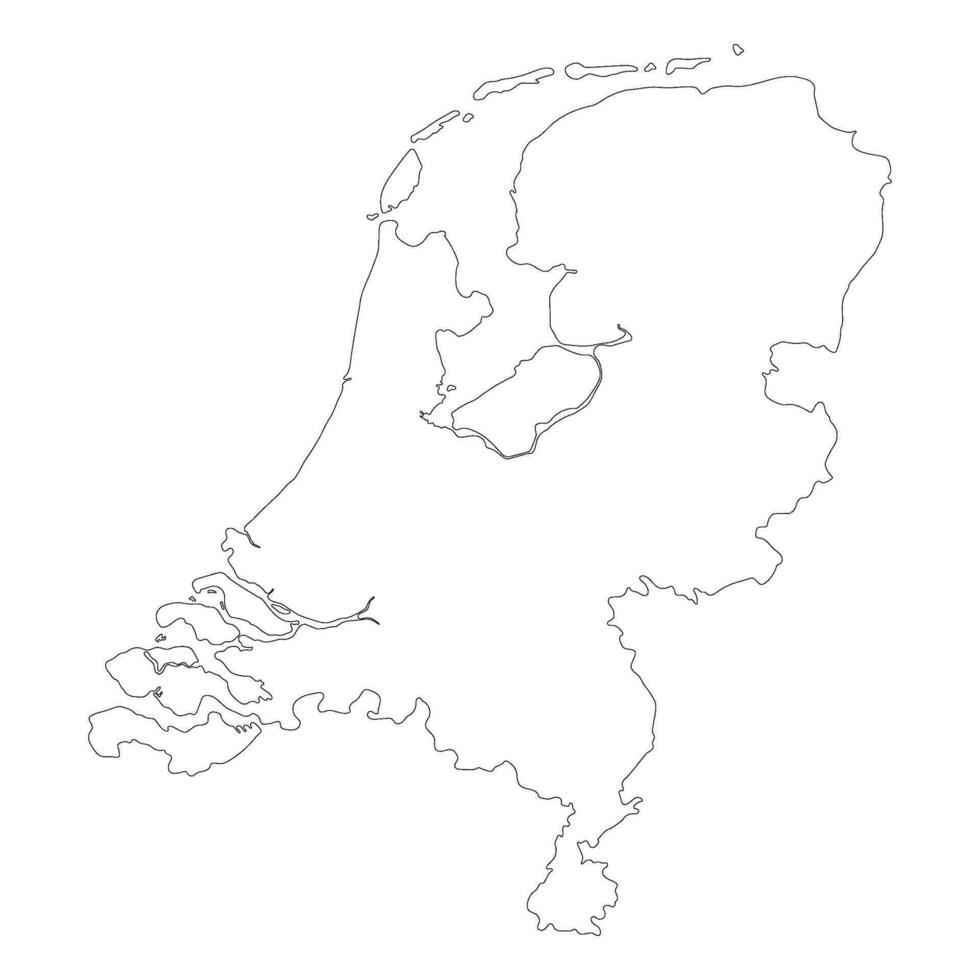Overview
Contents:
Location
The project site is located in the planned 'Sluisbuurt' neighborhood of Amsterdam. At the eastern end of the city's harbor, Amsterdam is building numerous artificial islands to combat its housing crisis. This area has been used for plenty of innovation and experimentation in modern residential architecture. Sluisbuurt is located at the Northwestern end of Zeeburgereiland, with views of the Oosterdok islands across the water. The neighborhood is not currently built, but is surrounded by other new neighborhoods.
Design Assignment
This fictional assignment was a part of my Bachelor's program. The concept was that everyone would individually work on one plot/building, but that as a group we would produce one cohesive neighborhood, so that we would experience the overlap between Architecture and Urban Design. This included designing public spaces as well. The aim was to research and experiment the concept of living, what it truly means and what is needed to make this possible. In addition, the buildings were required to provide high-density living, communal and/or public functions, and be sustainable.
Functions of Living
What does it mean to live? What does one need and want in their house? How are designers supposed to answer these questions, and what role should they play in this? These, and many more questions, were posed for us to think about in this course. In response, the first step I took in the research-design process was to inventorize different actions, functions, furniture, facilities, etc. one would use in their house. I did two inventories: one by the 'rooms' one would typically find certain facilities and do certain actions, and another by order in which one would go through a routine (eg. waking up in the morning to get ready for work). Next, I connected the loose cloud of words together, grouping them by practicality, use, and routine, to establish an understanding of which actions and objects should be more adjacent, and which would act more as intersections along multiple 'routes' over the mind map. From this analysis, I started to produce 'floor plans' in which functions were clustered together to create defined zones. The entirety of this exercise provided insights and understanding into the relations between different functions, and challenged my understanding of typical arrangements of spaces and functions. Insights derived from this analysis would be crucial for the development of the project's concept.
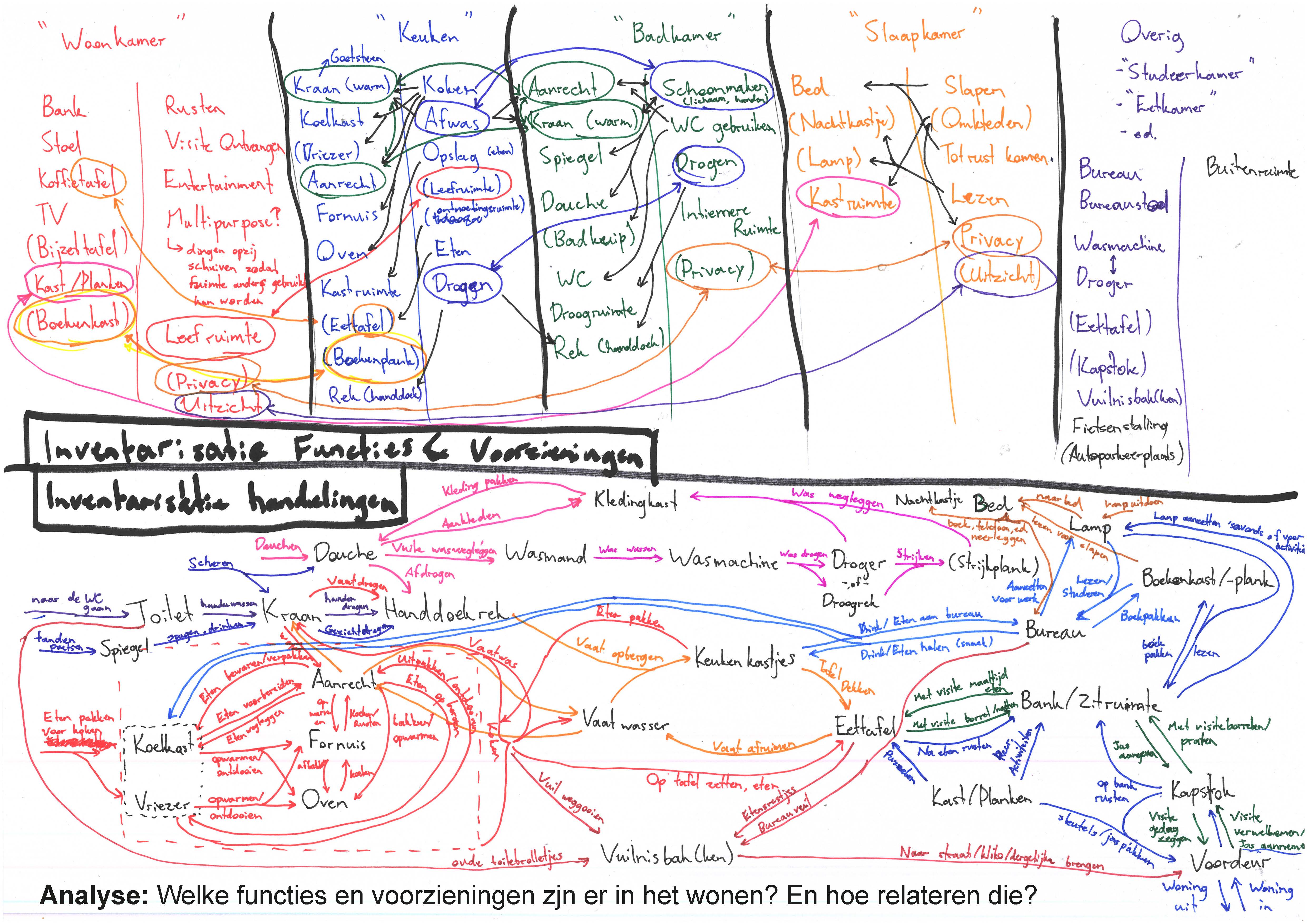
Analysis of different functions, how they would interact (below) and where they are traditionally found (above)

Analysis of different functions, how they would interact (below) and where they are traditionally found (above)
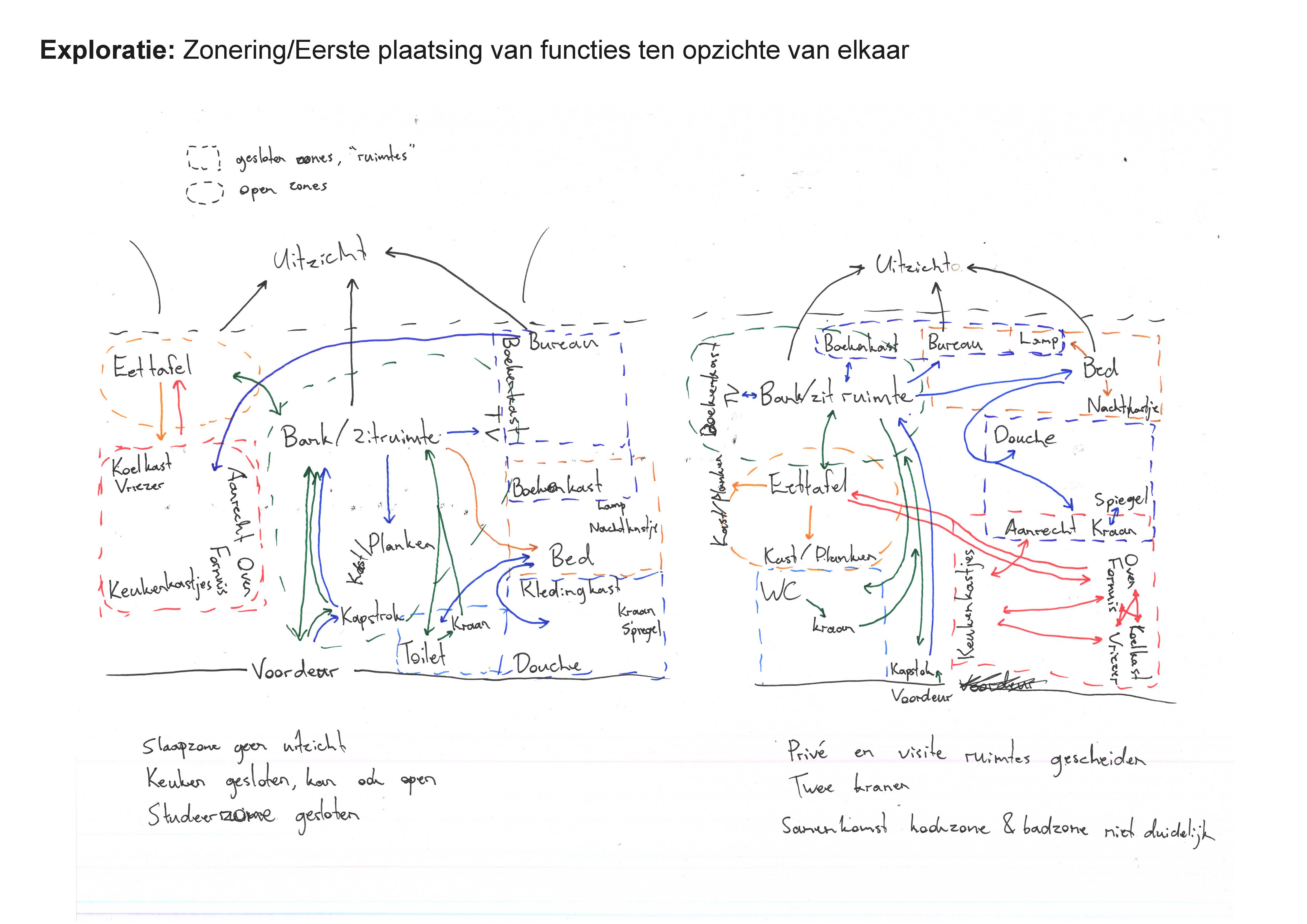
Attempts at arranging functions about each other, rather than individual 'rooms'

Attempts at arranging functions about each other, rather than individual 'rooms'
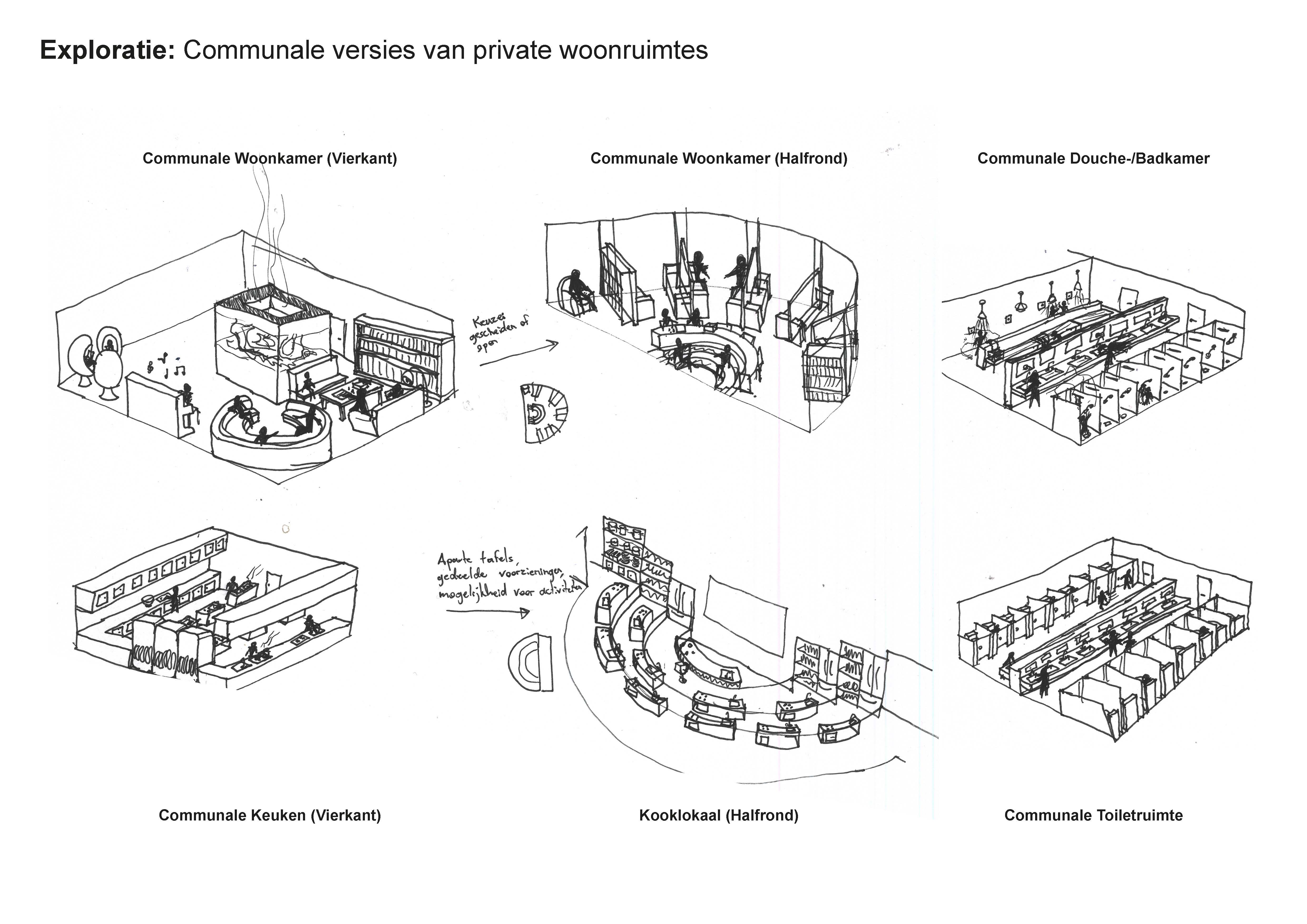
Experiment to see what spaces might look like if traditional 'rooms' were to be a communal facility outside of the individual's dwelling

Experiment to see what spaces might look like if traditional 'rooms' were to be a communal facility outside of the individual's dwelling
In addition to the previous two analyses, a third analysis was performed to experiment with the concept of co-living and collective spaces. Much work has already been done with regards to communal facilities and spaces, but I wanted to see what might happen if traditionally individualized spaces were made to be collective, outside of the private residence. To see what such spaces would look like, and how they would function, I sketched out some concepts in the third image above. I attempted to see what a kitchen, living room and bathroom would look like if it existed centrally for an entire apartment building, the results of which can be seen above.
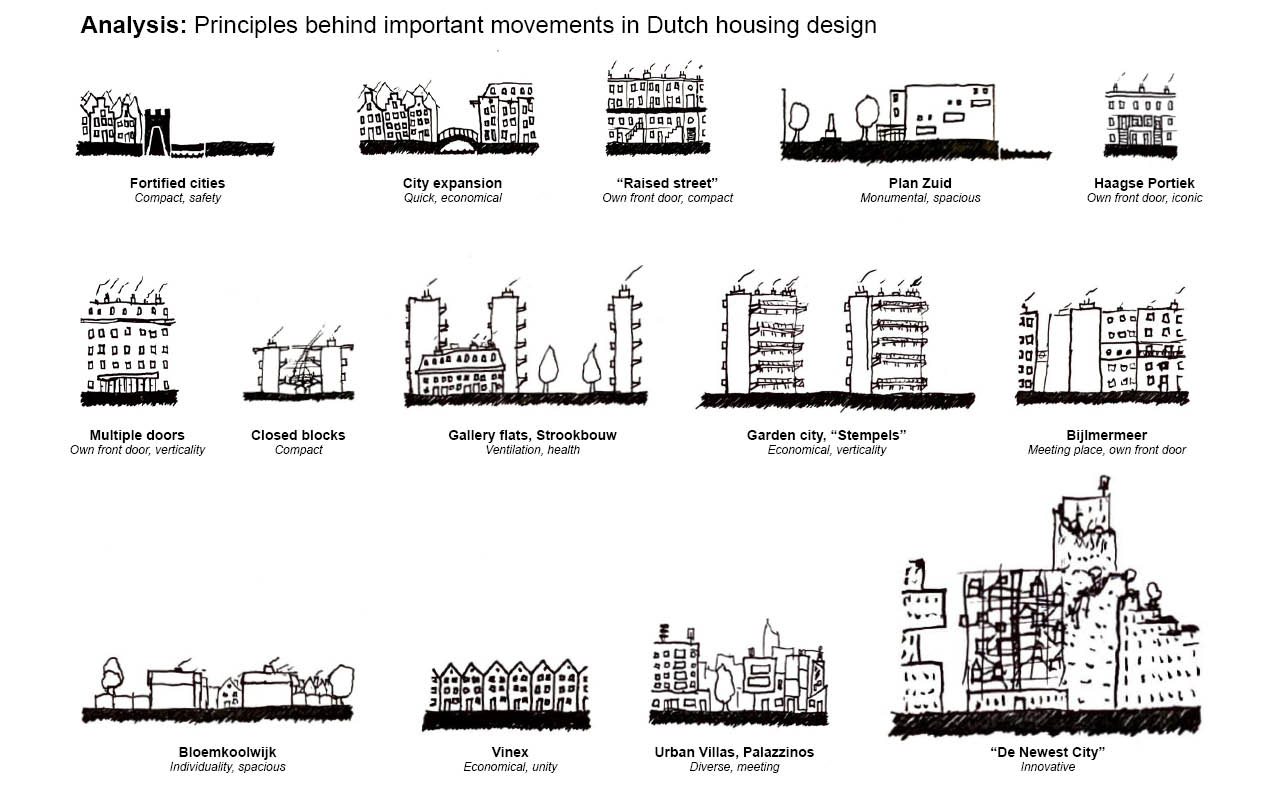
Analysis of Dutch Housing movements and their aims

Analysis of different housing movements in Dutch history and the key aspects behind their philosophies
History of Dutch Housing movements
The first step I took in the design process for this project was to research the outcomes and goals of historic housing movements. The image to the rightabove is a summary I made based on the lecture given by our dean, Dick van Gameren. During the lecture, the history of Dutch housing was discussed at length, describing major movements, the reasons they came to be and developed into what they were, as well as their successes and failures, and how, ultimately, new movements arose to respond. In the summary I produced, one can see the rough architectural expression it invokes, as well as the ideals that were held in their development. Each period and plan is hailed for bringing new ideas to the table, through innovation or the revival and re-appreciation of old ideas. By looking at each period I was able to make a list of ideals which would serve as a starting point for the main concept of my design. This list and the eventual concept can be found below.
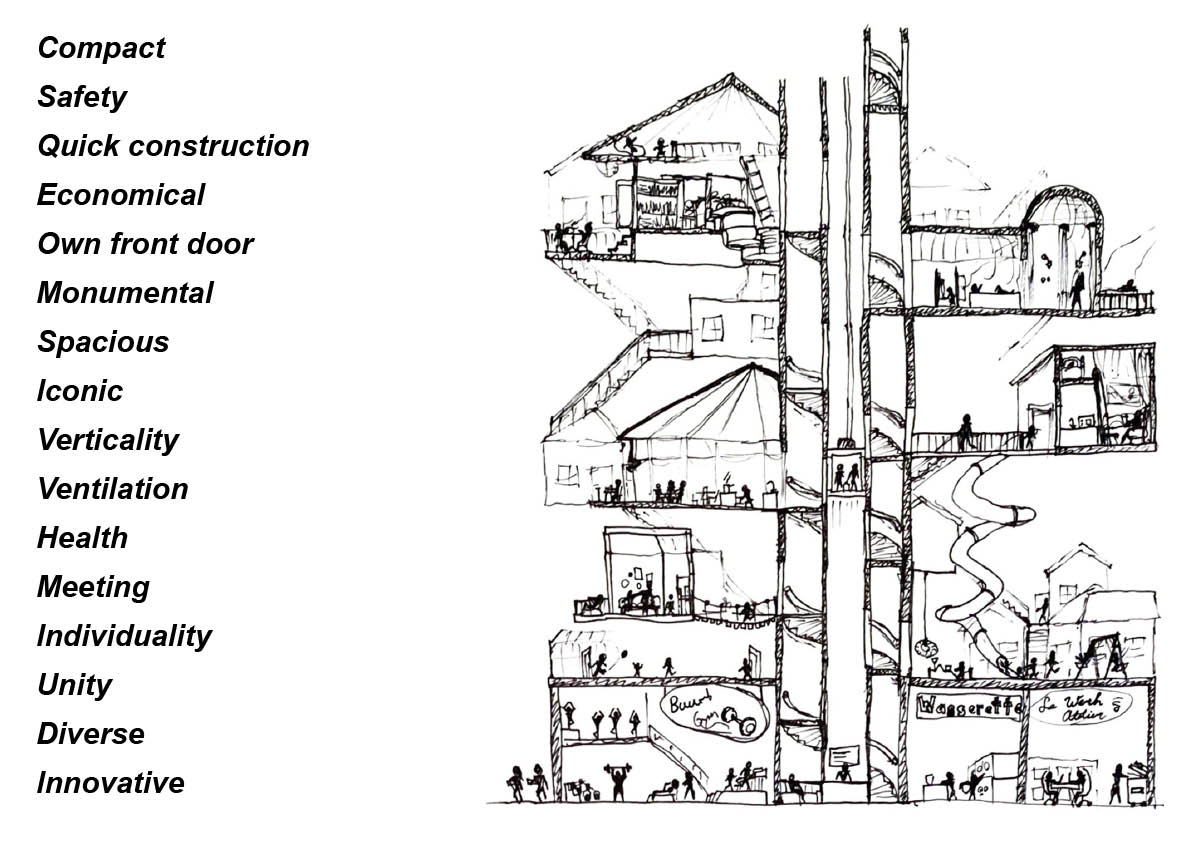
First concept sketch and primary goals

Drawing summarizing the main concept of the design
Blending Living and Leisure
Based on the research I did, and the scope of the assignment, I decided the main focus of the building should be about having playful and enjoyable elements to justify higher densities. By having communal functions, a creating monumental and fun experience, living more compact becomes more appealing. In addition, my personal stance toward housing architecture is that it often lacks a principle or concept which make it more appealing to the user, and less so the investor. This design course provided an excellent opportunity to experiment with such a concept.
It takes a (vertical) village
One of the issues often found with densified and urban living conditions is high anonymity and a lack of community. As such, one of the principles I wanted to integrate in the building was a sense of neighborliness, a strong identity for the community to live in, a safe place for everyone to interact with each other. The inspiration taken for applying this principle is that of a village; having a defined, individual space which can be personalized to express oneself, and a communal space where one can meet in comfort creates a much stronger sense of belonging necessary for successful community-building.
Main Concepts
As described above, the main idea for the building is to create a fun and dynamic building, with plenty of communal spaces and facilities to encourage neighborly interaction. This occurs at two levels: within the building, and within the larger neighborhood. The city of Amsterdam has envisioned the Sluisbuurt area to be a mixed-use area, primarily focussed on leisure and targeted towards the middle and upper segments and towards family households. As such, I wanted to focus on giving families a strong sense of an individual space, within a greater communal whole. The first diagram below shows how individual units exist as unique objects bound together to create dynamic spaces around a central core/hub where most interaction takes place. An additional concept that was considered was variation: not all households are the same, so to impose a one-size-fits-all model is inappropriate here. In the second diagram, it can be seen that the individual 'houses' can be variated upon for individual expression, up- and downsizing.
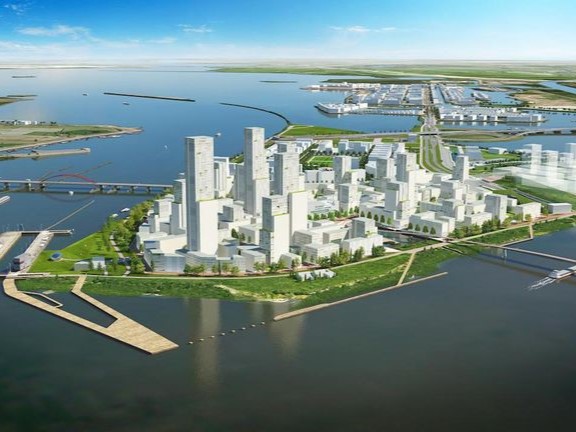
Vision for the development of Sluisbuurt

Vision for the development of Sluisbuurt
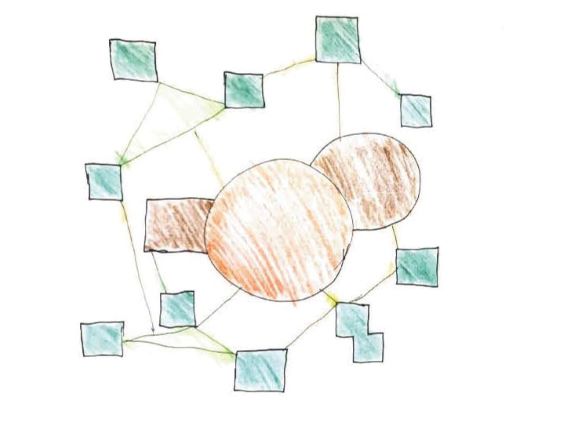
Diagram of the arrangement of public and private spaces through volumes

Diagram of the arrangement of public and private spaces through volumes

Diagram fo the expandable concept of the modular unit-based design

Diagram fo the expandable concept of the modular unit-based design
Plans & Sections
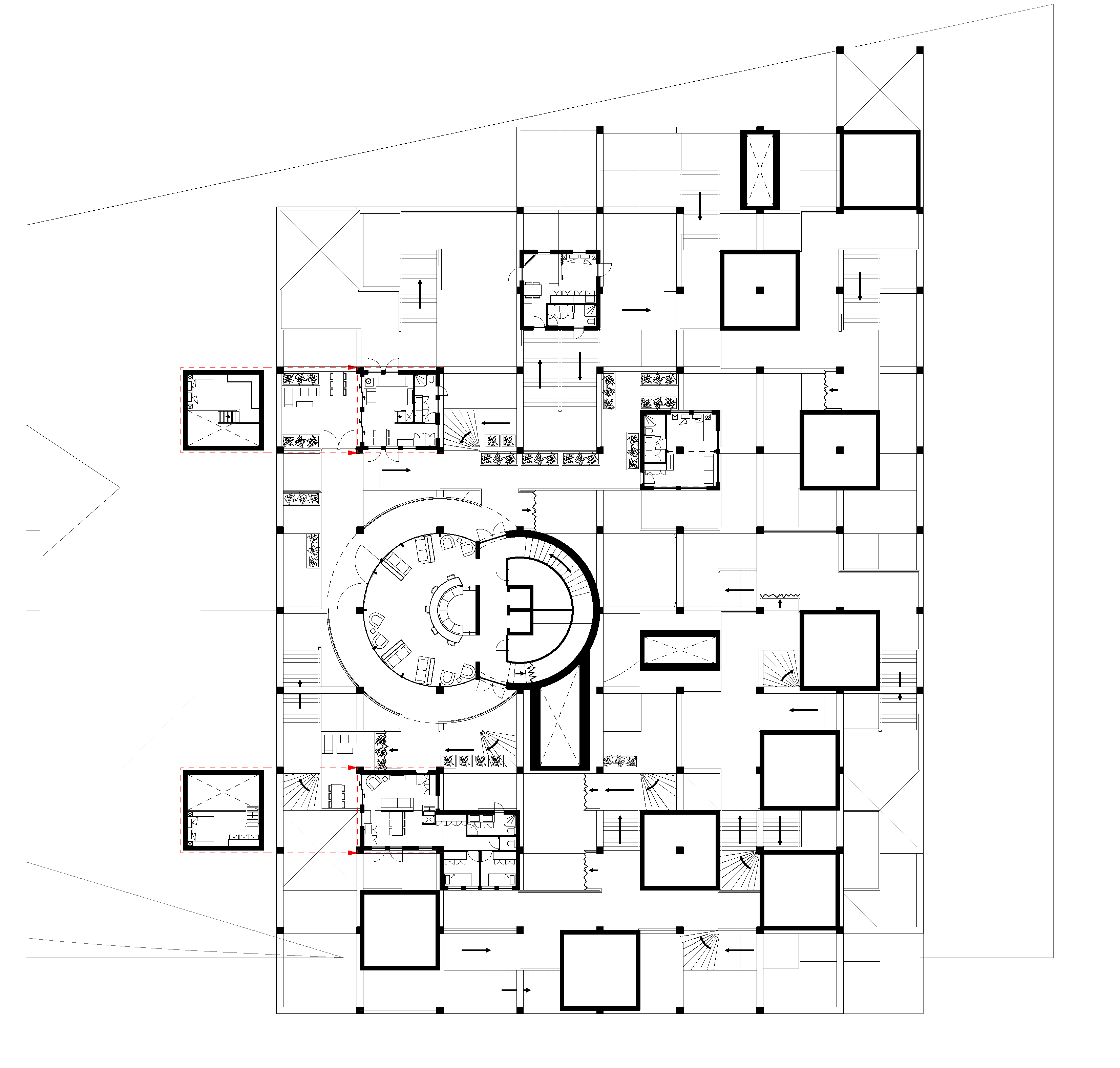
Floor plan for the fourth floor of the building

Floor plan for the fourth floor of the building
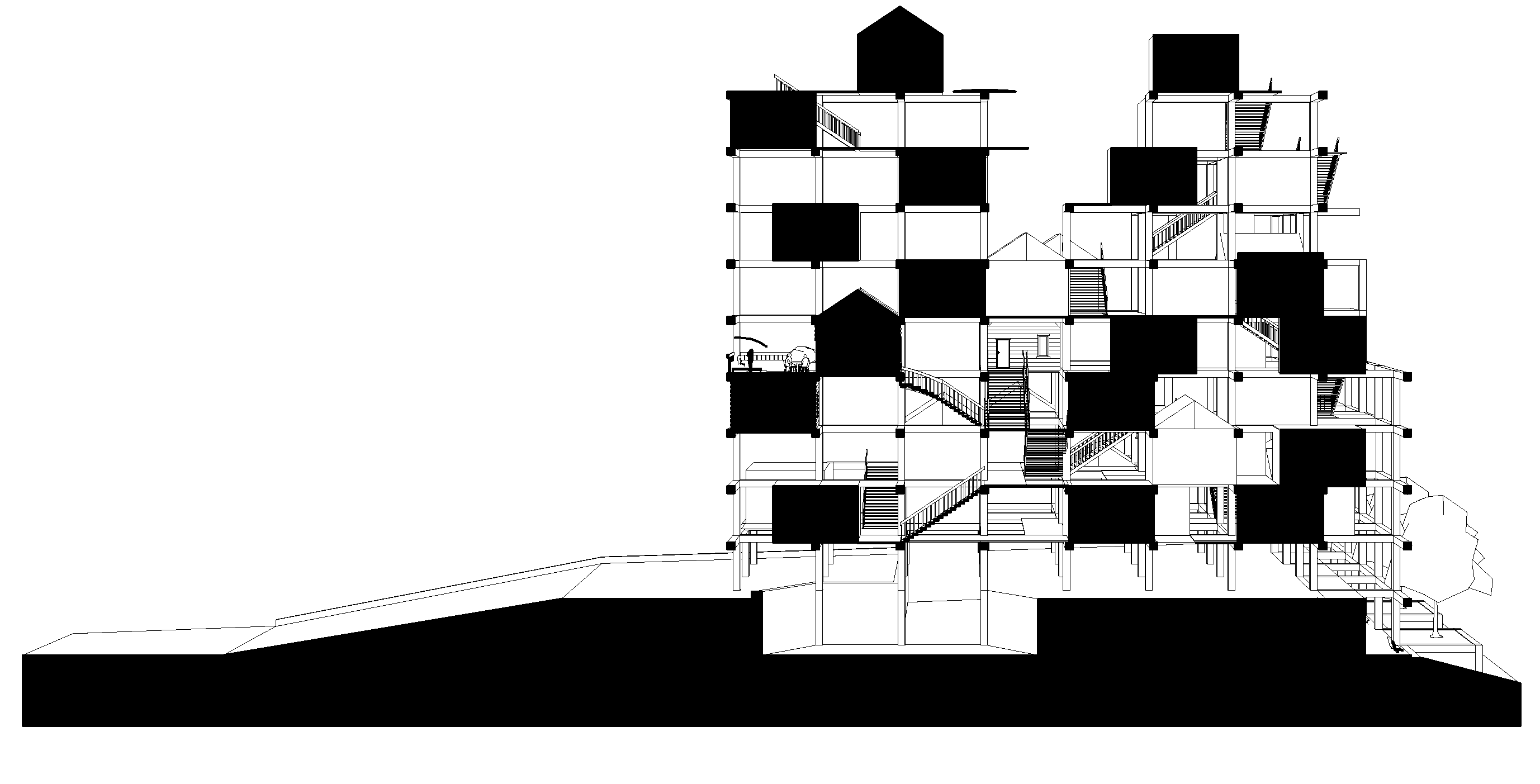
Section through the building, showing the use and arrangement of spaces

Section through the building, showing the use and arrangement of spaces
Composition
As shown in the diagram earlier, the main concept is that all the residences are individual units suspended around a central core, which houses most of the communal functions and facilities. All these spaces are connected through walkways and staircases to create a fun, lively and diverse array of spaces between them. The chaotic arrangement of volumes and connections allows for unique places to arise, creating a lively sense of adventure for residents when looking for a spot to meet and interact.
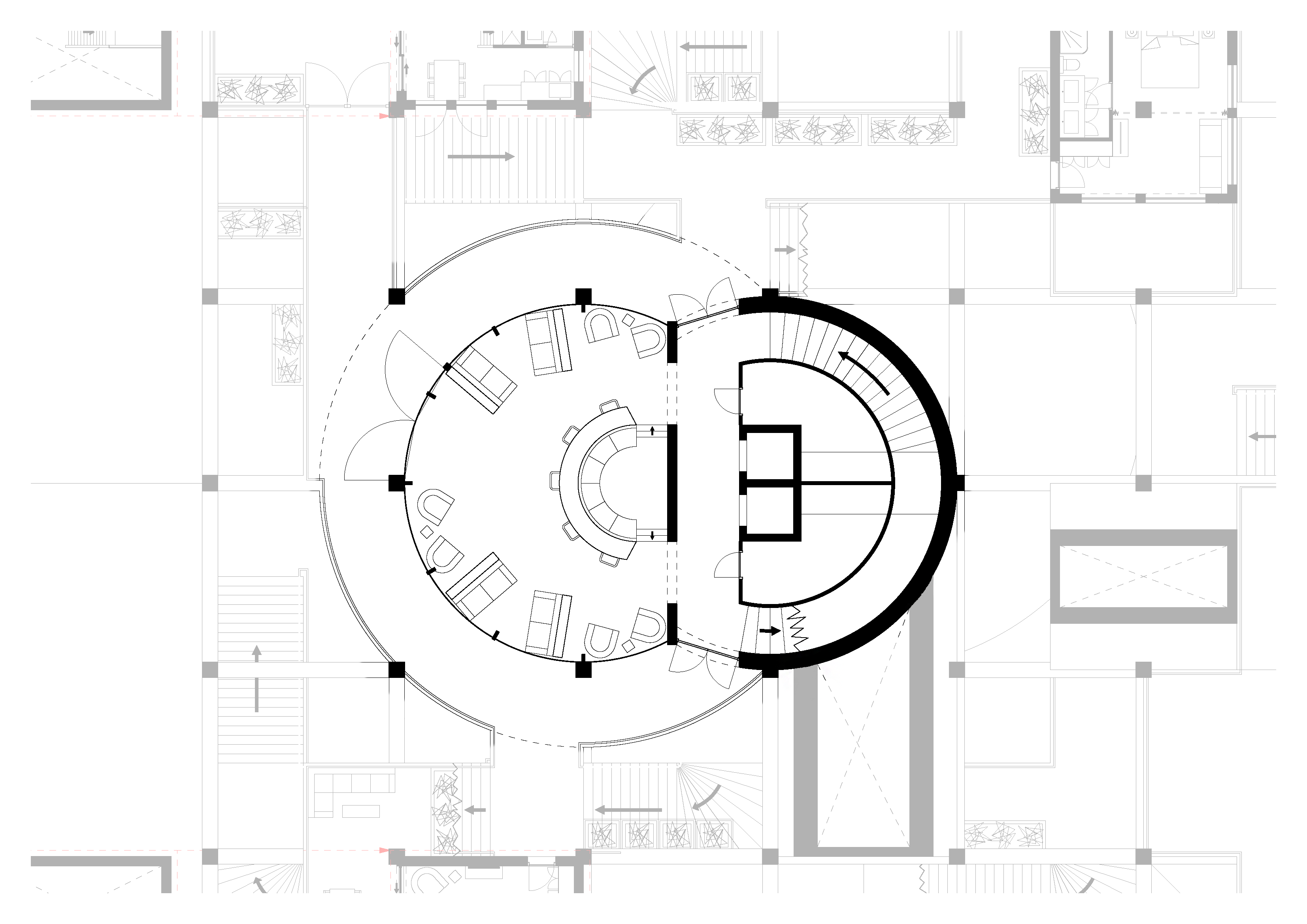
Plan for the communal living room located on the 4th floor

Plan for the communal living room located on the 4th floor
Communal Spaces
To encourage interaction between residents, and to foster a sense of community, the building features several communal spaces. If one's apartment begins to feel cramped or lonely, there are common living rooms, kitchens and gardens available to sit and work, relax and interact with neighbors. On the left,In the image above, one can see a plan for one such communal living room. It features a few nooks for quieter, more private interaction, as well as a central conversation pit, complete with a fire place. There are bookshelves and windows all around, providing excellent views and the ability to host an array of events in the space.
Apartments
The individual apartments are all self-standing units, characterized by standard variations of a 'base' unit. This, combined with their unique positioning within the greater whole, means that every apartment has its own experience. Some examples of apartments are shown below. In the first and second image, we see how the top apartment can make use of the apartment diagonally below it, by using its roof as a terrace. The second image also shows a 'base' unit, one block with no additions. Inside, we see that it has a bathroom, kitchenette, closet space, bed room and minimal living room. The smaller living room was chosen because it encourage more use of outdoor and communal areas, but still makes it possible to relax within one's own apartment. In the third image, we can see a double-sized unit with an adjacent terrace. Such apartments are generally targeted towards (larger) families who would require additional bedrooms.
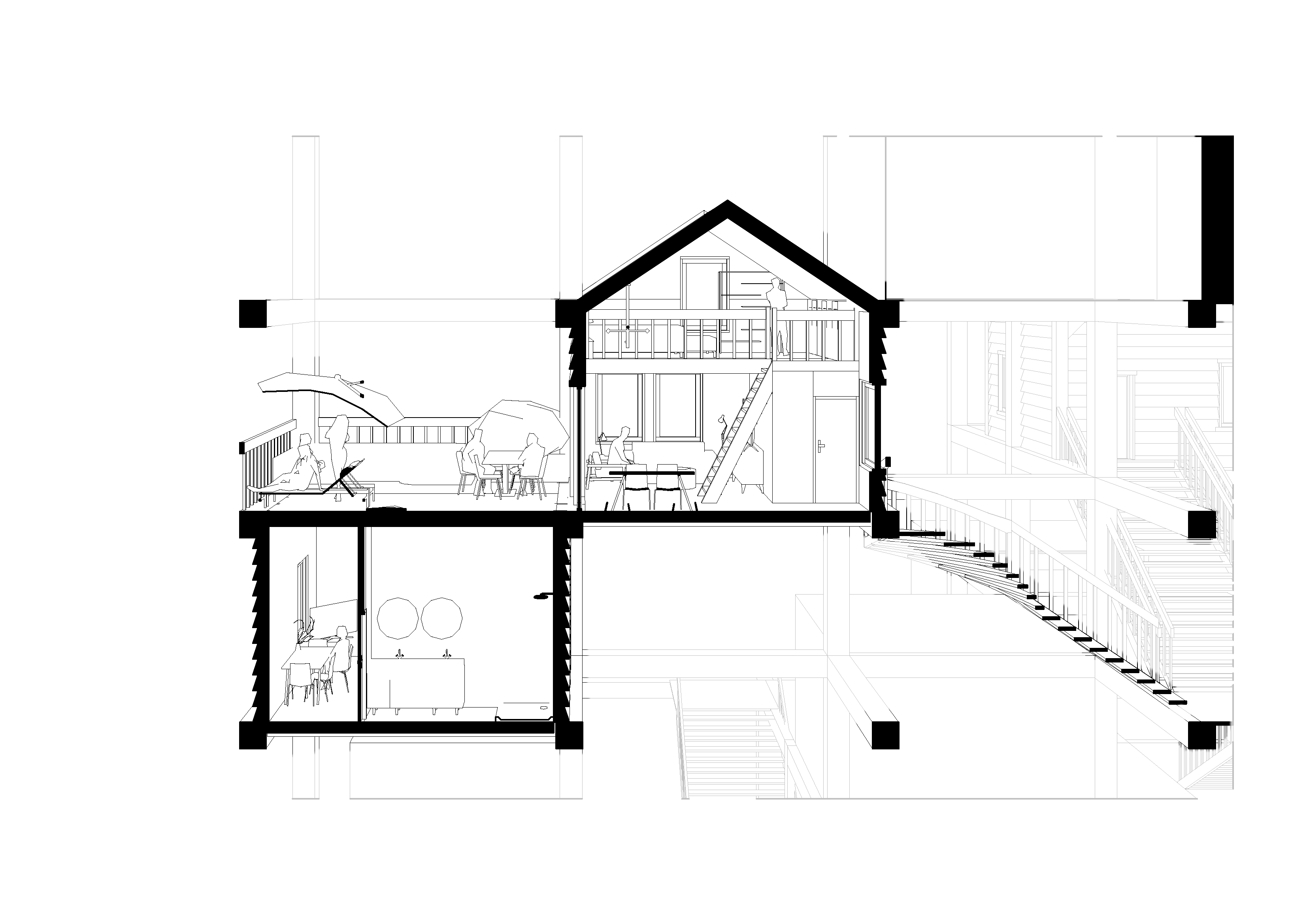
Section through two units, one of which uses the roof of the other as a terrace

Section through two units, one of which uses the roof of the other as a terrace
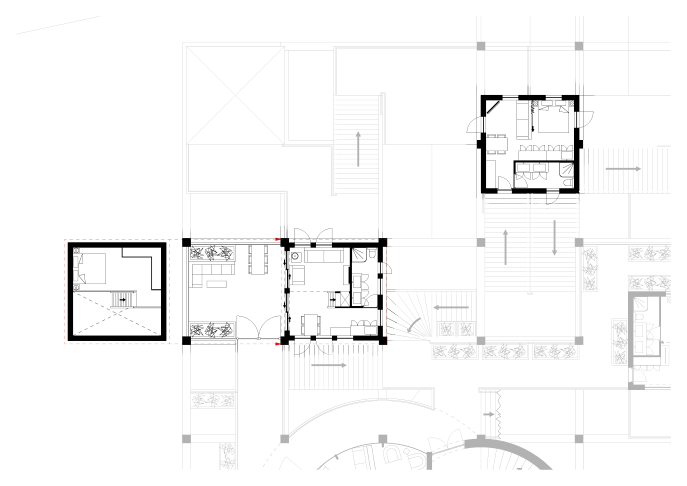
Plans for a unit with a full terrace adjacent, and a single unit with no additions

Plans for a unit with a full terrace adjacent, and a single unit with no additions
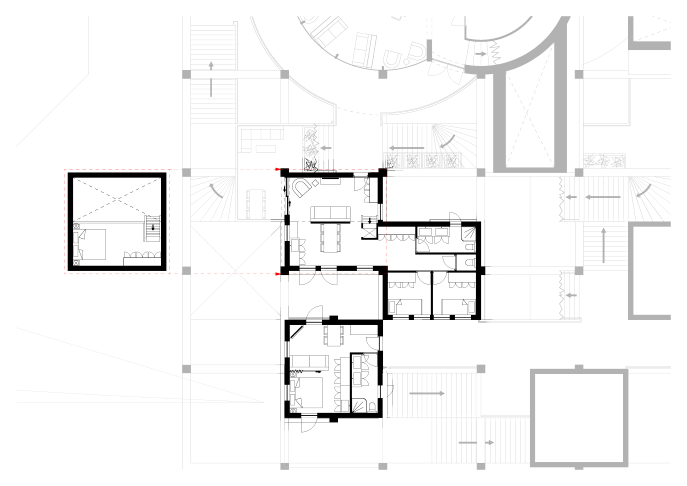
Plans for a double-sized unit and a single unit nearby

Plans for a double-sized unit and a single unit nearby
Project Renders
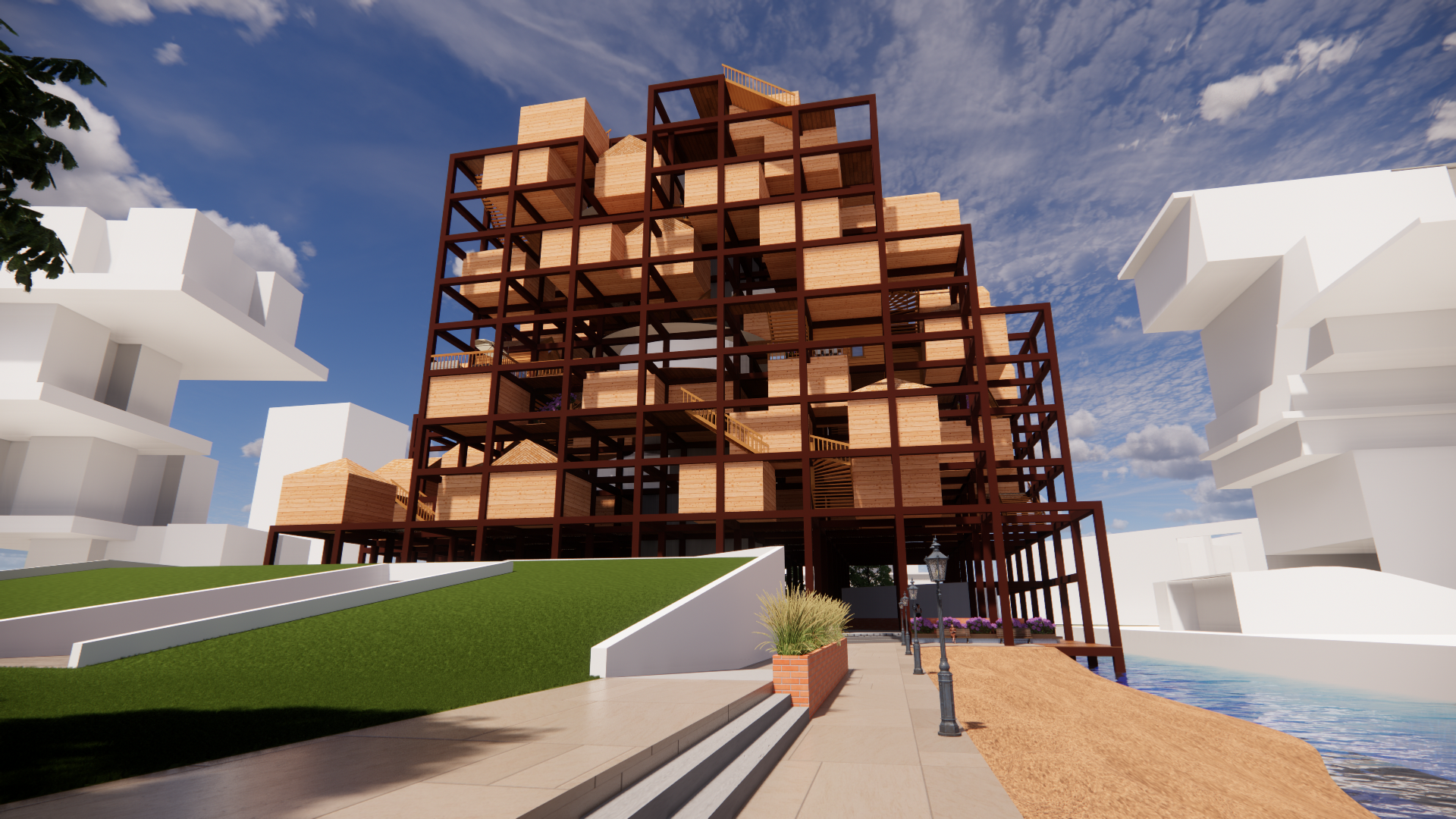
Beach next to building
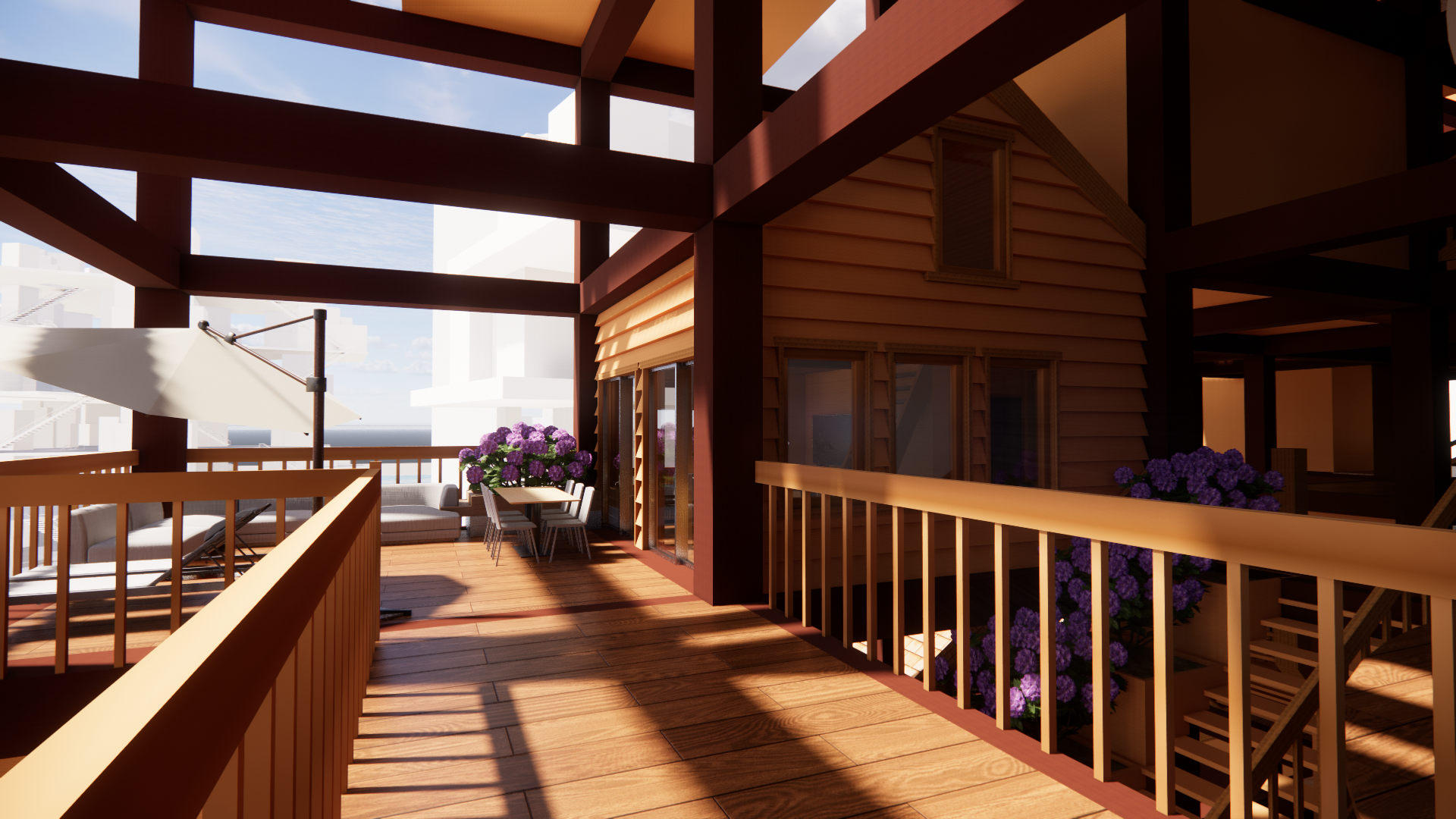
Transition public to private deck
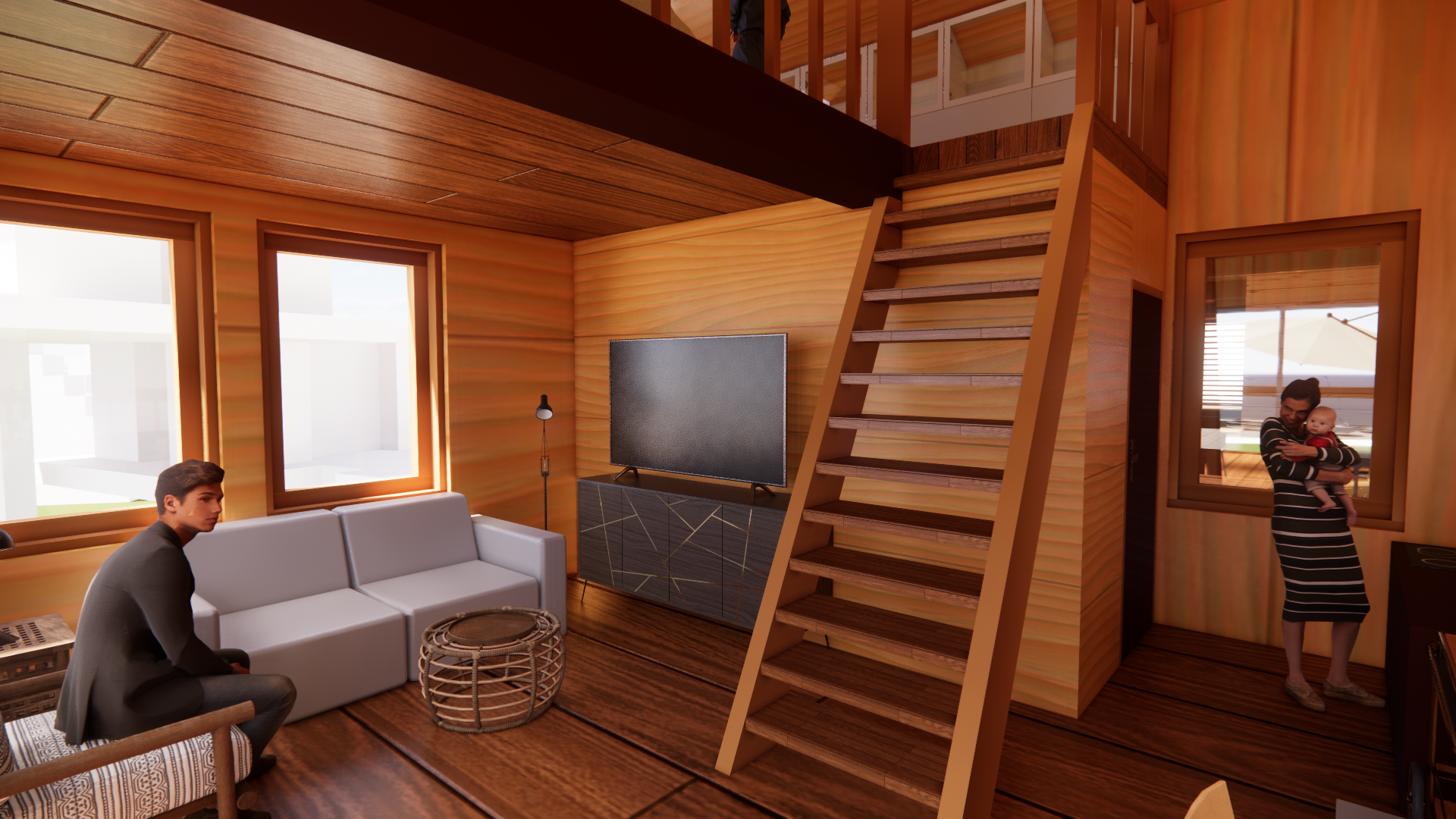
Example of a unit's interior
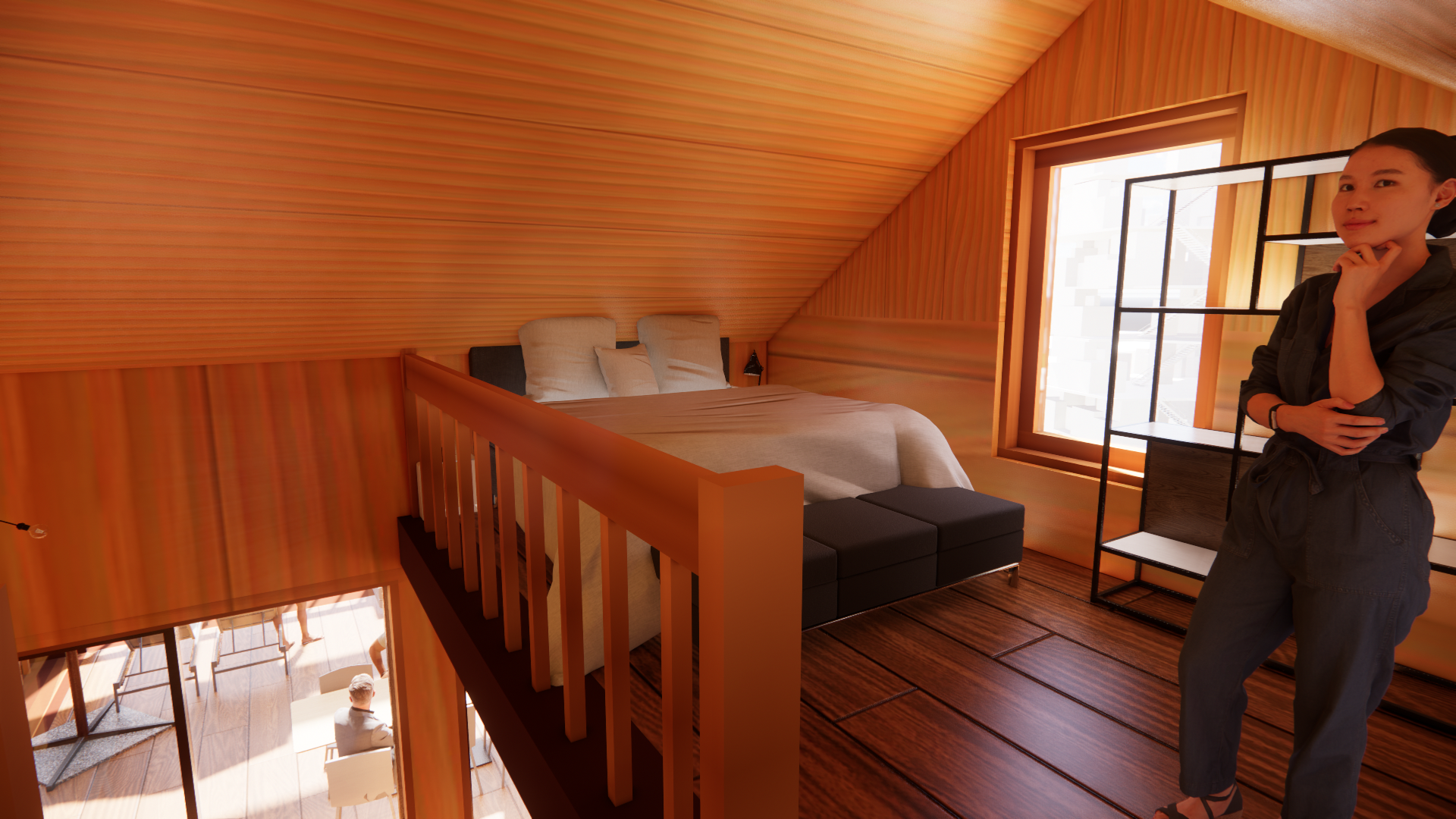
Example of a loft unit
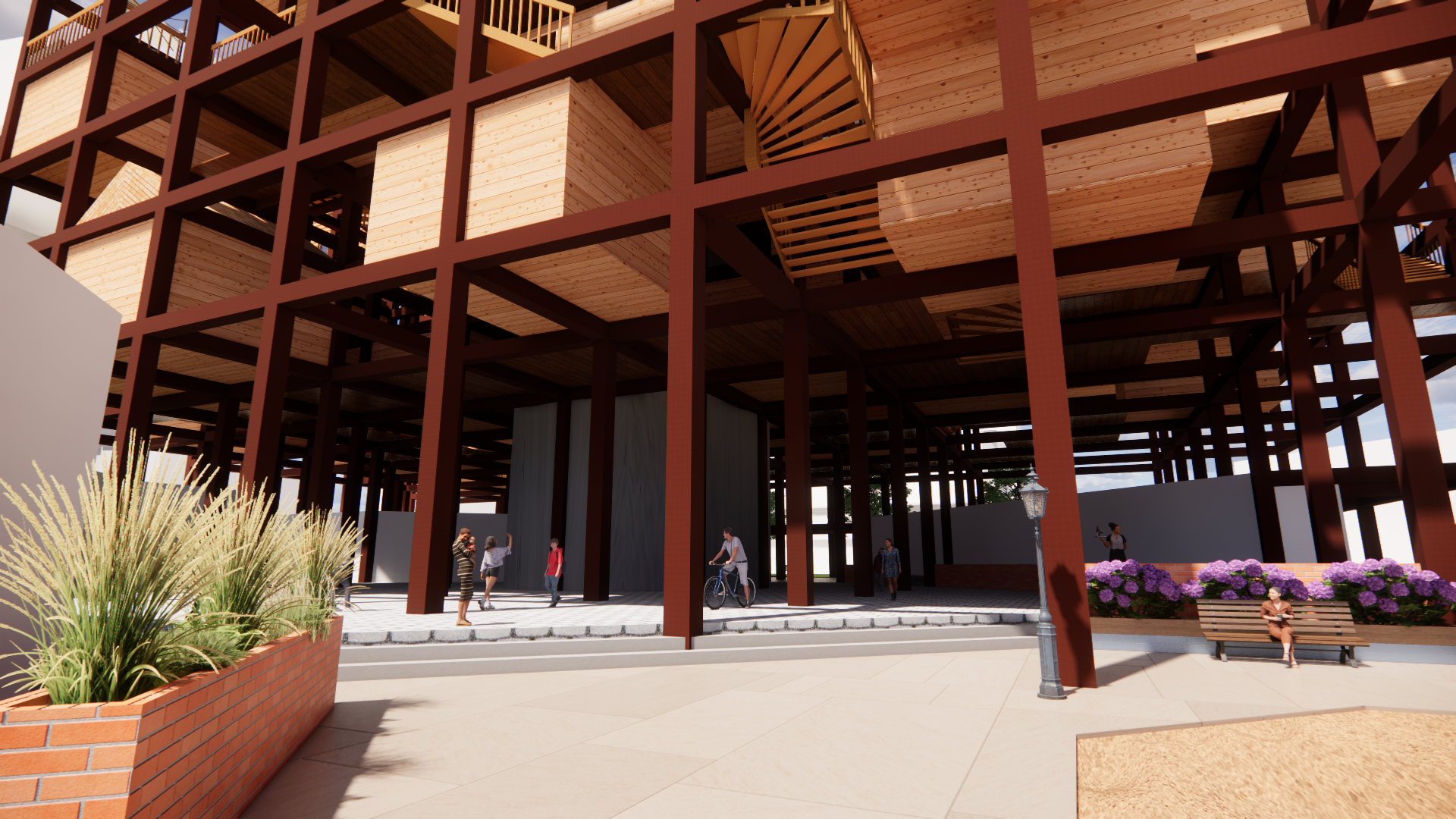
Shopping square under building
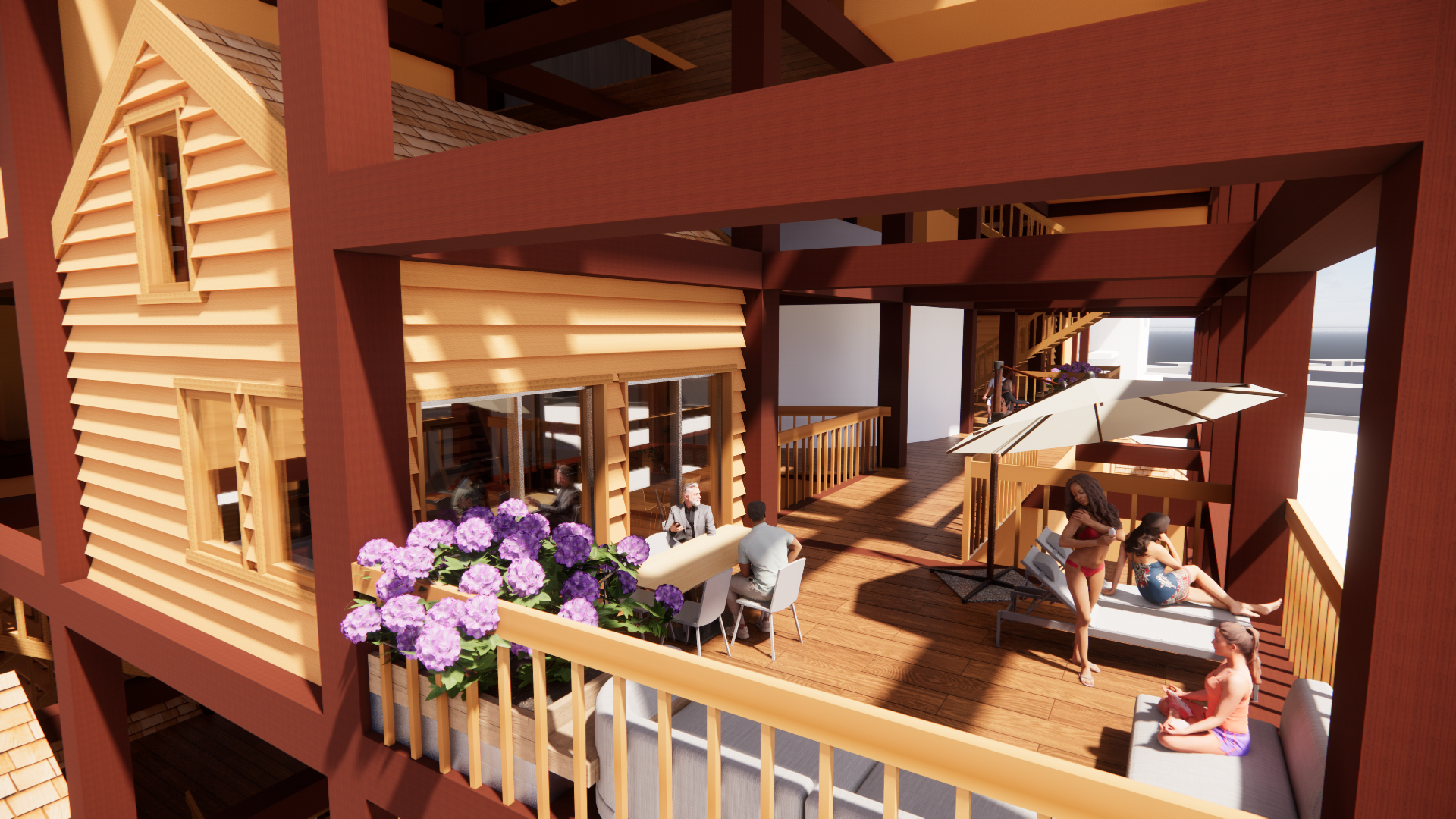
Example of a private terrace
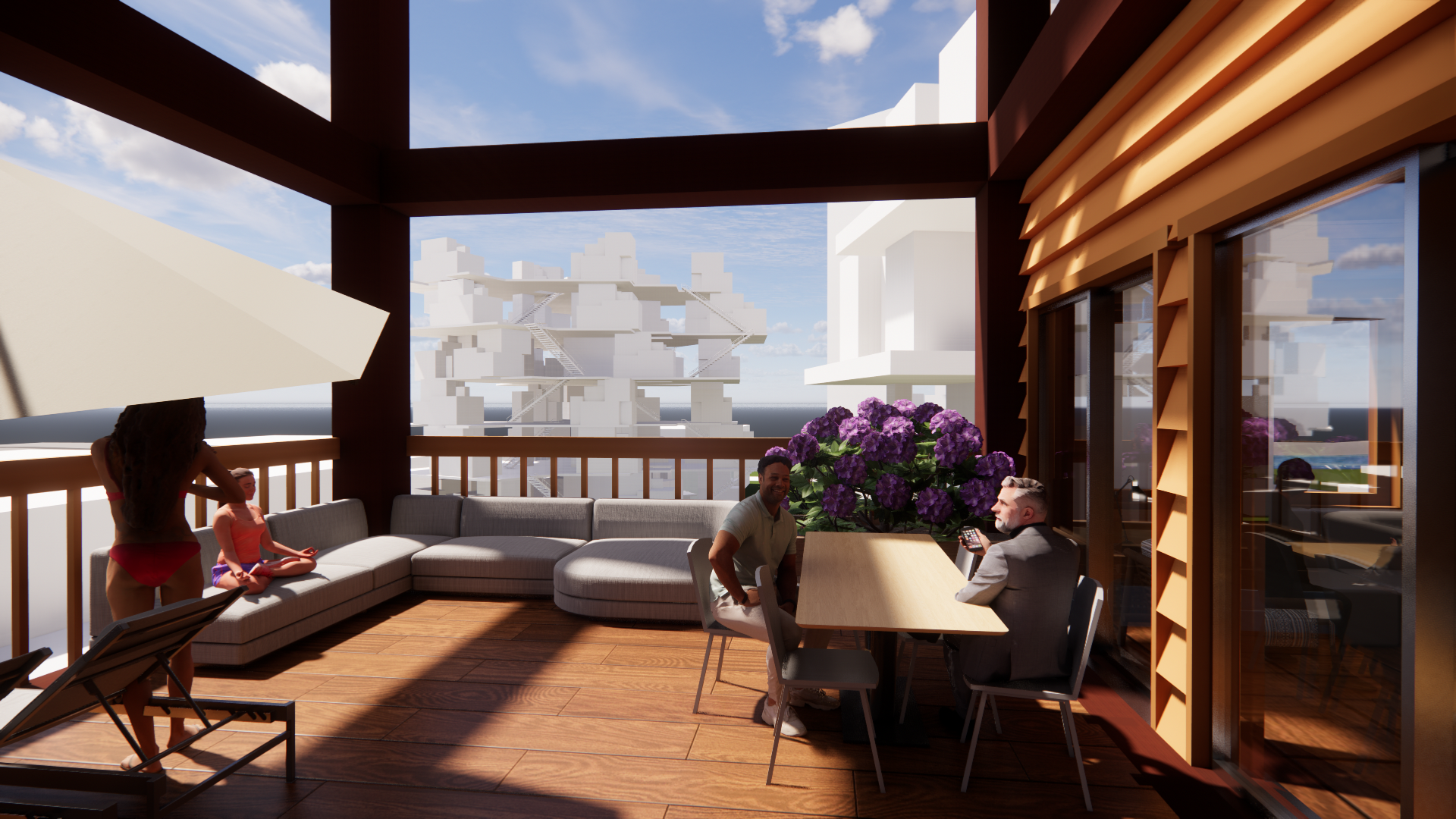
Example of a private terrace's view
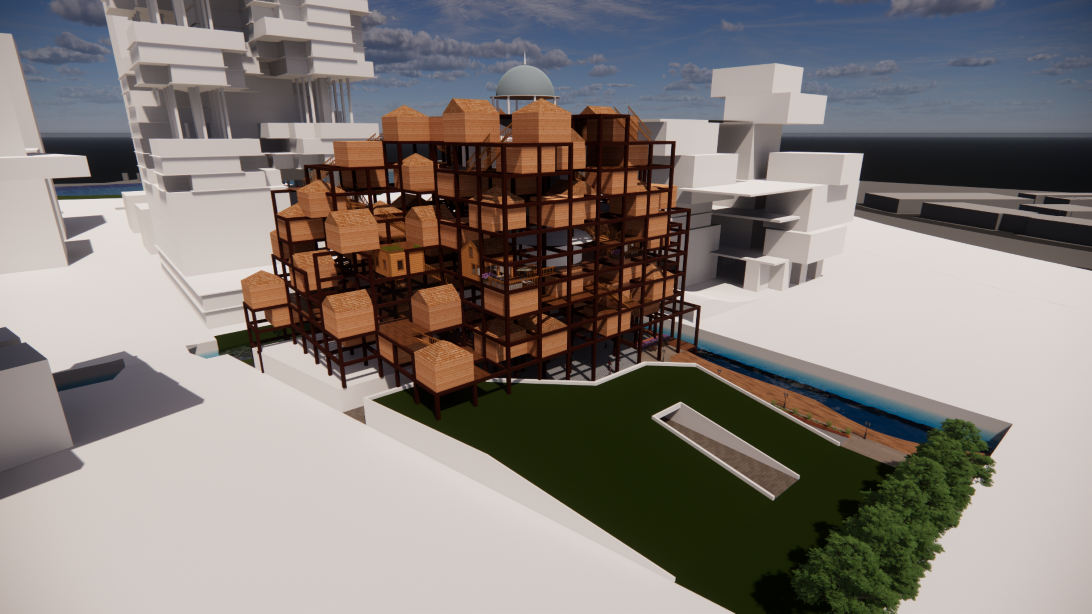
Bird's eye view of the building in the neighborhood
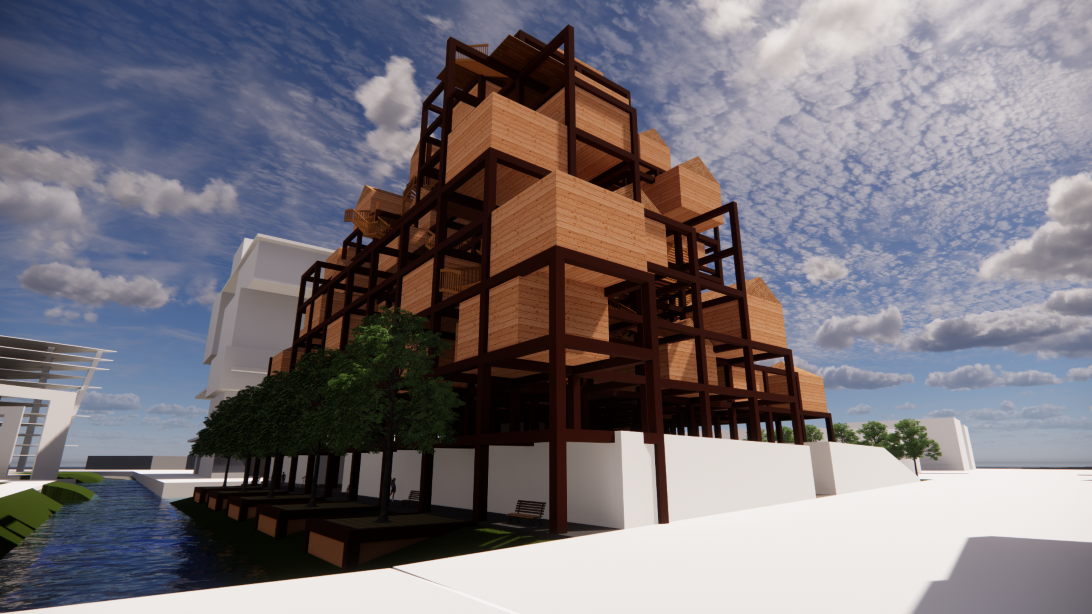
View from the Northwestern corner
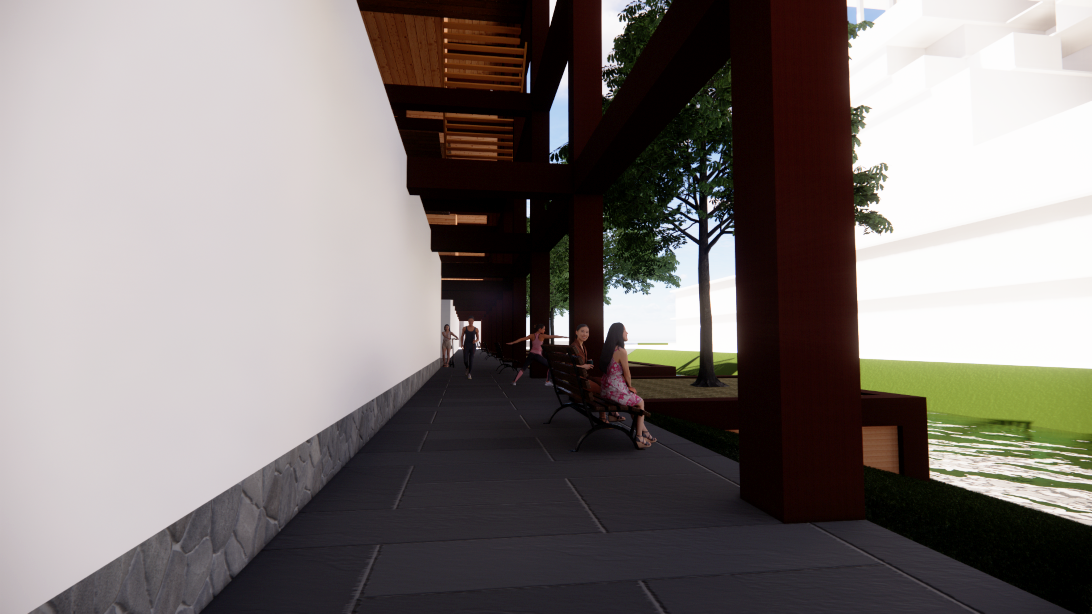
Recreational walk along the waterfront
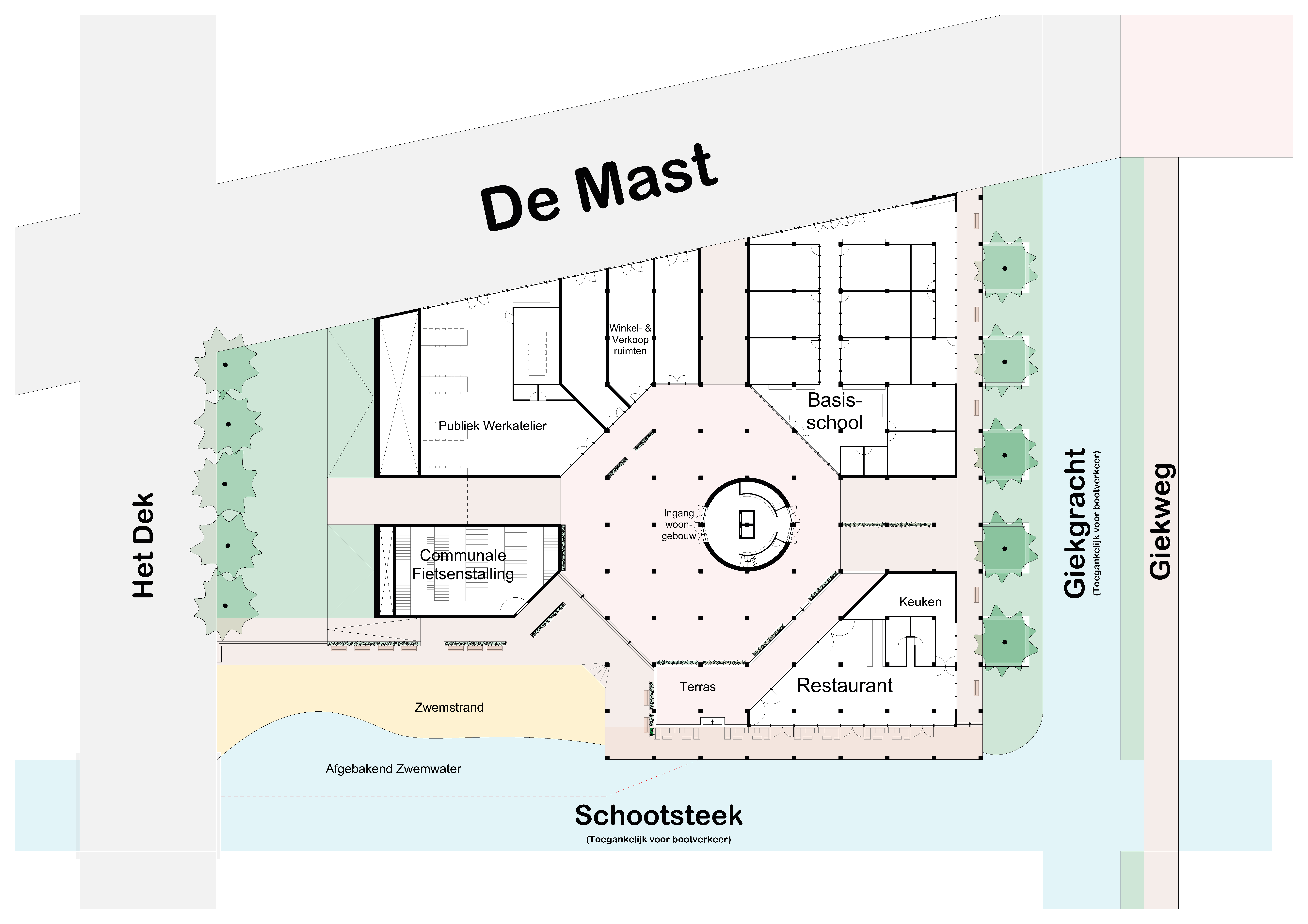
Plan showing the project at the ground level and how it relates to its surroundings

Plan showing the project at the ground level and how it relates to its surroundings
Relation to surroundings
One of the key aspects to the assignment was to collaborate with my fellow students to produce a cohesive and dynamic neighborhood. As such, my building, which is located on a relatively central plot would play a key part in that. As one of the few buildings targeted towards families and children, it made sense to house the neighborhood's primary school in the building. The ground level also features commercial space and a public workspace where people can come and concentrate if they lack a space to work properly from home. In addition, the plot is surrounded on two sides by water accessible to boats. The neighborhood, which is aimed to focus on leisure and interaction with the water (which is why all the streets and waterways are named after parts of a sailboat), it made sense to create walkways, greenery and terraces along the water. Along with a restaurant and a swimming beach, the building becomes a destination of its own right within the neighborhood, and creates more space for interaction between residents of the building and the neighborhood.
Other projects
Read more about related projects, or return to the project overview.
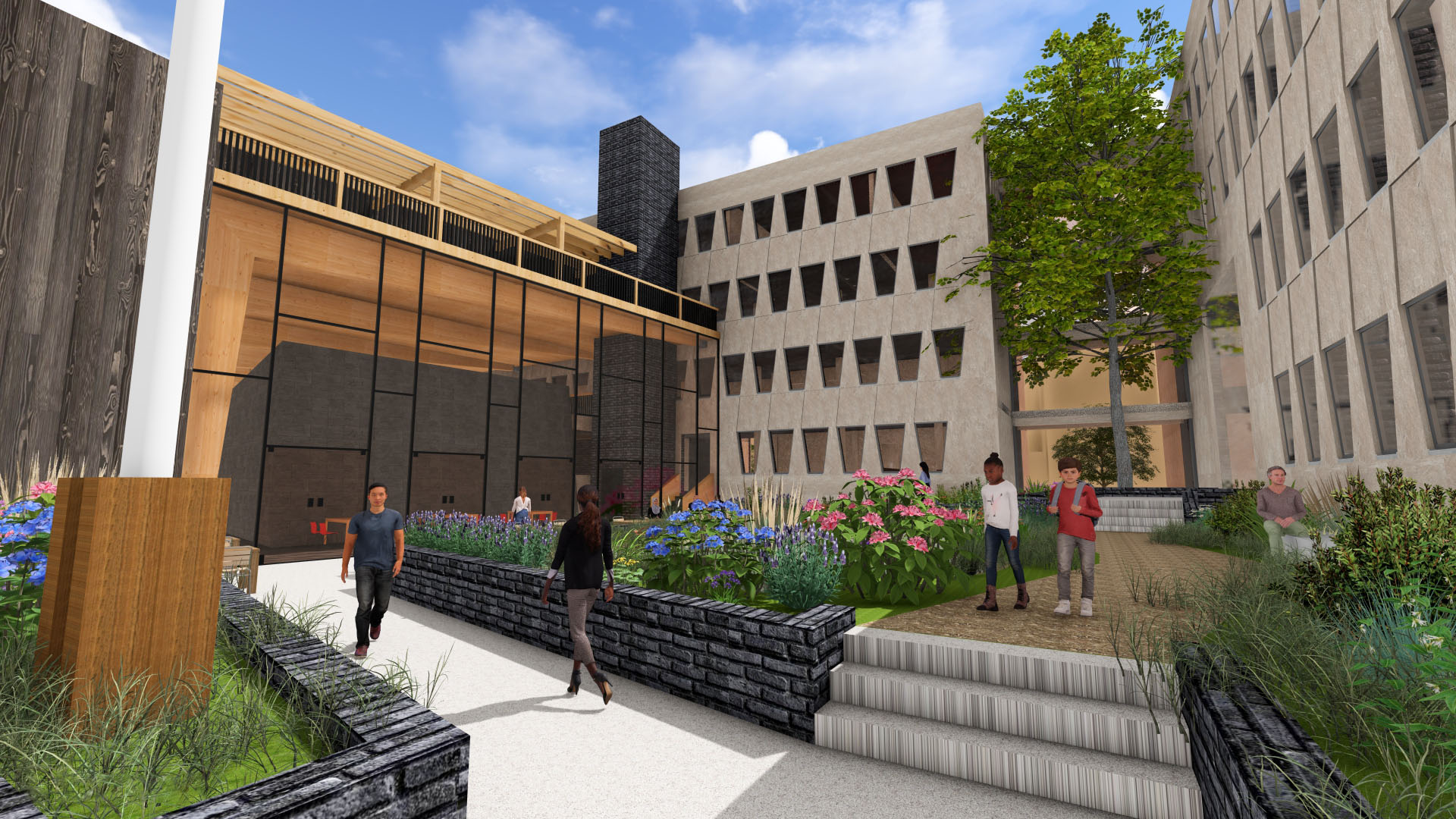
Most recent project
Tying Up Loose Ends >>
This redesign of the former United States Embassy to the Netherlands, located in the Hague, is all about blending existing values with new applications.

DuDock House >>
A passenger terminal for automated RoBoats. Includes a small museum for the concept, as well as the main RoBoat workshop and traffic control.
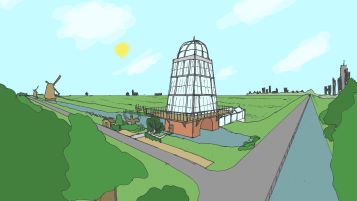
Very first project
Novo Molinus >>
A housing project for a park ranger, which also features a public learning and visitor's center, is an exemplary case of blending public and private life.
